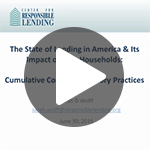In this final chapter of The State of Lending in America and its Impact on U.S. Households series, we demonstrate the cumulative high costs of lending abuses, discuss lessons learned from efforts to address predatory lending, and suggest steps for further action. This chapter comprises the following sections:
- Lending Abuses and Their Costs describes how various types of lending abuses create excessive costs for families, communities, and the economy. Specific estimates are included where available.
- Who Pays discusses ways that consumers use credit and who is most affected by lending abuses. It also provides evidence that borrowers who fall prey to one abusive loan are often vulnerable to other lending abuses.
- Cumulative Impact draws from the previous two sections to describe how the costs of lending abuses compound for borrowers and communities.
- A Role for Regulation reviews past regulation of financial products and services, which has successfully prevented lending abuses while still preserving access to credit.
In this chapter, we show that the costs of lending abuses are substantial and wide-ranging. Although we cannot estimate the precise cost of all predatory lending practices, those that we can estimate establish that at a minimum hundreds of billions of dollars are drained from borrowers, communities, and the economy.
Specific findings in this chapter include:
- Loans with problematic terms or practices result in higher rates of default and foreclosure/ repossession.
- The consequences of default, repossession, bankruptcy, and foreclosure are long-term.
- The opportunity costs of abusive loans are significant.
- Abusive loans have an impact on the economy as a whole.
- Across many financial products, low-income borrowers and borrowers of color are disproportionately affected by abusive loan terms and practices.
- Loans with problematic terms are repeatedly concentrated in neighborhoods of color.
- Debt plays a profound role in the financial lives of most American households, with about three-quarters of households having at least one form of debt and many having multiple forms of debt.
- Regulation and enforcement is an effective means for ending lending abuses while preserving access to credit.
Download the executive summary. (PDF)
Descargue el resumen ejecutivo. (PDF)
Conversation with Sarah Wolff [Webinar Recording]
Watch a recording of the June 30, 2015 webinar where Sarah Wolff, author of this chapter of the State of Lending, presented her research and answered questions from participants.
Event Photos, June 2015
View an album of photos from the panelist presentations of the June 16, 2015 research event: including José Cisneros, Kausar Hamdani, and Marceline White.
Highlights from the Panelist Presentations [PDF]
Download presentations from three of the panelist presentations from the June 16, 2015 research event: José Cisneros, Kausar Hamdani, and Marceline White.


